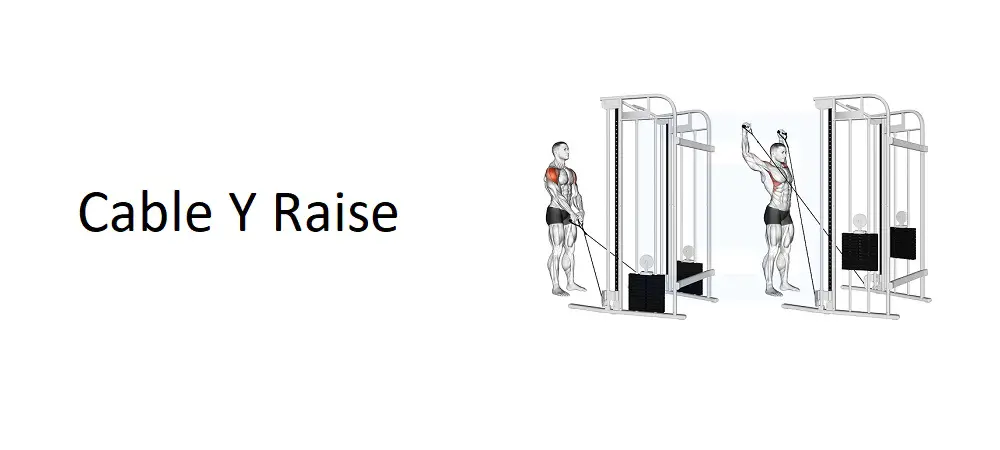Table of Contents
Introduction:
The Cable Y Raise is an excellent shoulder and upper back exercise that targets the rear deltoids, trapezius, and rotator cuff muscles. It’s especially valuable for improving posture, shoulder stability, and overall upper body definition. By utilizing a cable machine, this exercise provides constant tension, making it an effective alternative to dumbbell Y raises.
The Cable Y Raise can be done as part of a shoulder, back, or upper-body workout routine. It’s suitable for people at all fitness levels and can be modified with lighter weights to help beginners focus on form or heavier weights for more advanced muscle activation.
Instructions: How to Perform Cable Y Raise
- Set Up the Cable Machine: Adjust the cable machine to the lowest setting and attach two single handles on each side. Select a moderate weight that allows you to perform the movement with control and proper form.
- Grip and Positioning: Stand in the center of the cable machine, with your feet shoulder-width apart. Grasp the handles with an overhand grip (palms facing down) and position your arms in front of your body.
- Starting Position: Lean forward slightly at the waist to about a 45-degree angle, keeping your back straight, chest out, and core engaged. Hold the handles in front of you, with a slight bend in the elbows.
- Y Raise Motion: Slowly lift your arms up and out to form a “Y” shape, keeping your palms facing down and maintaining a slight bend in the elbows. Raise the handles until your arms are parallel to the ground or slightly above, feeling the contraction in your upper back and shoulders.
- Controlled Lowering: Slowly lower the handles back to the starting position, keeping tension on the muscles throughout the movement.
- Repetitions: Aim for 10–15 reps per set, with 3–4 sets in total.
Pro Tips:
- Avoid swinging or using momentum, and focus on a controlled, steady motion to maximize muscle activation.
- Keep your shoulders relaxed and avoid shrugging them up towards your ears.
- Engage your core throughout the movement to maintain a stable and balanced posture.
Benefits of Cable Y Raise
The Cable Y Raise provides a range of benefits that make it a worthwhile addition to any upper body workout:
- Targets Rear Deltoids and Upper Back: This exercise primarily engages the rear deltoids and upper back muscles, improving shoulder stability and posture.
- Improves Posture: By strengthening the muscles that pull the shoulders back and down, this exercise can help counteract poor posture due to sitting or hunching over.
- Strengthens Rotator Cuff: The Cable Y Raise engages the rotator cuff muscles, which are essential for shoulder stability and reducing the risk of injury.
- Continuous Tension: The cable machine provides consistent resistance throughout the entire range of motion, making it an effective option for maximizing muscle engagement.
- Injury Prevention: Strengthening the smaller muscles of the shoulder and upper back helps stabilize the shoulder joint, which is essential for preventing injuries during heavier compound lifts.
Muscles Worked in Cable Y Raise
The Cable Y Raise is an effective isolation exercise that works several upper-body muscles:
- Rear Deltoids: This muscle at the back of the shoulder is the primary target, responsible for shoulder abduction and external rotation.
- Trapezius (Upper and Lower): The trapezius assists in controlling the shoulder blades and stabilizing the upper back during the movement.
- Rhomboids: These muscles help retract and stabilize the shoulder blades, assisting in proper posture.
- Rotator Cuff Muscles: The rotator cuff provides shoulder stability and supports safe, smooth movement.
- Serratus Anterior: This muscle stabilizes the shoulder blade, supporting shoulder movement and helping prevent winging of the scapula.
Video on How to Do Cable Y Raise
Other Names for Cable Y Raise
The Cable Y Raise may be referred to by other names depending on the gym or the equipment used. Common alternatives include:
- Cable Rear Delt Y Raise
- Standing Cable Y Raise
- Cable Y Shoulder Raise
The exercise remains the same regardless of the name, focusing on the upper back and shoulder stabilizers.
FAQs
1. Should beginners try the Cable Y Raise?
Yes, this exercise is beginner-friendly. Start with a light weight to focus on proper form and technique, then gradually increase the weight as you become more comfortable.
2. How does the Cable Y Raise compare to the Dumbbell Y Raise?
Both exercises are effective, but the cable version offers consistent resistance throughout the movement. This keeps the muscles engaged continuously, which is especially beneficial for isolating smaller muscle groups.
3. How heavy should the weight be for the Cable Y Raise?
Since this is an isolation exercise targeting smaller muscles, use a moderate weight that allows you to control the movement. Focus on performing each rep with a slow, controlled pace.
4. Can I perform this exercise sitting down?
Yes, you can perform a seated variation of the Y Raise if standing is uncomfortable. However, standing allows for better core engagement and posture control.
5. How often should I include the Cable Y Raise in my workout?
Include the Cable Y Raise 1–2 times per week, especially if your focus is shoulder and upper back strength. Pair it with other shoulder exercises like presses and lateral raises for comprehensive shoulder development.
Conclusion
The Cable Y Raise is a powerful addition to any shoulder or upper back routine. By targeting the rear deltoids, trapezius, and rotator cuff, this exercise not only enhances shoulder aesthetics but also improves posture and reduces the risk of injury. Its use of a cable machine ensures constant tension, helping you achieve optimal muscle activation throughout the movement.
Incorporate the Cable Y Raise into your workout to strengthen your upper body and build stability in the shoulders. As you progress, you’ll notice improvements in both your shoulder health and overall upper-body strength.








